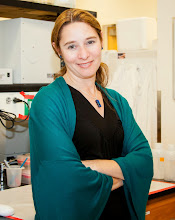On a fine Halloween day, why not sprinkle a little Halloween spirit into your talk? Dr. Gwenn Garden of the University of Washington did just that, giving us a little light-heartedness at the beginning of her neuroscience seminar today. Dr. Garden studies glia - the cells in our brains that neurons can’t live without. Rather than using a laser pointer to show us features on her slides, Gwenn used her fairy wand-today she was the glia fairy! Her opening slides also included analogies to candy corn-anyone hungry for some Halloween candy?
Halloween aside, Dr. Garden told us two stories today about different kinds of glia and how they work, or don’t work, in the case of neural degeneration. And she set the stage for her stories by giving us a little insight on how three men named Charles would think about glia: Charles Darwin (the evolutionary perspective), Charles Dickens (a tale of two glia), and Charles Shultz (Good grief Charlie Brown, glia are complicated!). After she had us all laughing, we were ready for her stories, complete with interesting data and complicated interactions between cells.
Dr. Garden showed off two important features of science communication:
1) If it’s a holiday, why not bring that holiday theme into the talk?
2) Serious science can be described with a smile, a laugh, and a few good stories.
So Happy Halloween! May your next talk be the right mix of glial fairy dust (or maybe astrophysics fairy dust if that’s more your thing) and good science with a good story.


No comments:
Post a Comment